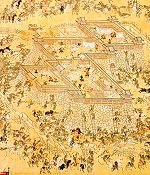Siege of Ulsan
| First Siege of Ulsan | |||||||
|---|---|---|---|---|---|---|---|
| Part of the Imjin War | |||||||
| |||||||
| Belligerents | |||||||
| Korea and China | Toyotomi Hideyoshi Japanese army | ||||||
| Commanders and leaders | |||||||
|
Gwon Yul Yang Hao Ma Gui | Katō Kiyomasa | ||||||
| Strength | |||||||
| 11,500 Koreans and 36,000 Chinese army | 5,000 Kato's army and 60,000 reinforcements[1] | ||||||
| Casualties and losses | |||||||
| 20,000 | 6,000 | ||||||
The Siege of Ulsan (Hangul: 울산성 전투, Hanja: 蔚山城戰鬪) was an unsuccessful Korean and Chinese attempt to capture Ulsan Castle from the Japanese late in the Imjin War. The Japanese suffered heavy losses during the siege.
First Siege of Ulsan

In 1597, Japanese decided to attack Korea again, but Japanese force retreated to the southern Gyeongsang province. Without provisions and reinforcements, the Japanese forces had to remain in the coastal fortresses (known as wajō) that they still controlled. The Japanese commander Katō Kiyomasa army were stationed in Ulsan, and Kato built a Japanese castle, Ulsan. Commanders Yang Hao and Ma Gui led an army of 36,000 Chinese, and Commander Gwon Yul led an army of 11,500 Koreans, in a first assault on January 29, 1598. They caught the Japanese army unawares and still encamped, for the large part, outside Ulsan's unfinished walls.
A total of around 36,000 troops with the help of singijeons and hwachas nearly succeeded in sacking the fortress, but reinforcements under the overall command of Mōri Hidemoto came across the river to aid the besieged fortress and prolonged the hostilities. Later, the Japanese troops were running out of food and victory was imminent for the allied forces, but Japanese reinforcements arrived from the rear of the Chinese and Korean troops and forced them to a stalemate. After several losses, however, Japan's position in Korea had significantly weakened.
Second Siege of Ulsan
On September 22, 1598, Korean and Chinese allied forces made a second attack against Japanese forces. The alliance army formation was Commander Ma Gui, leading an army of 24,000 Chinese army, and an army of 15,000 Koreans were led by general Kim Eung-seo. However, Korean and Chinese allied forces failed to take the Ulsan Japanese Castle.
References
- ^ 朝鮮日日記, Japanese Buddhist monk Keinen (慶念) written.
